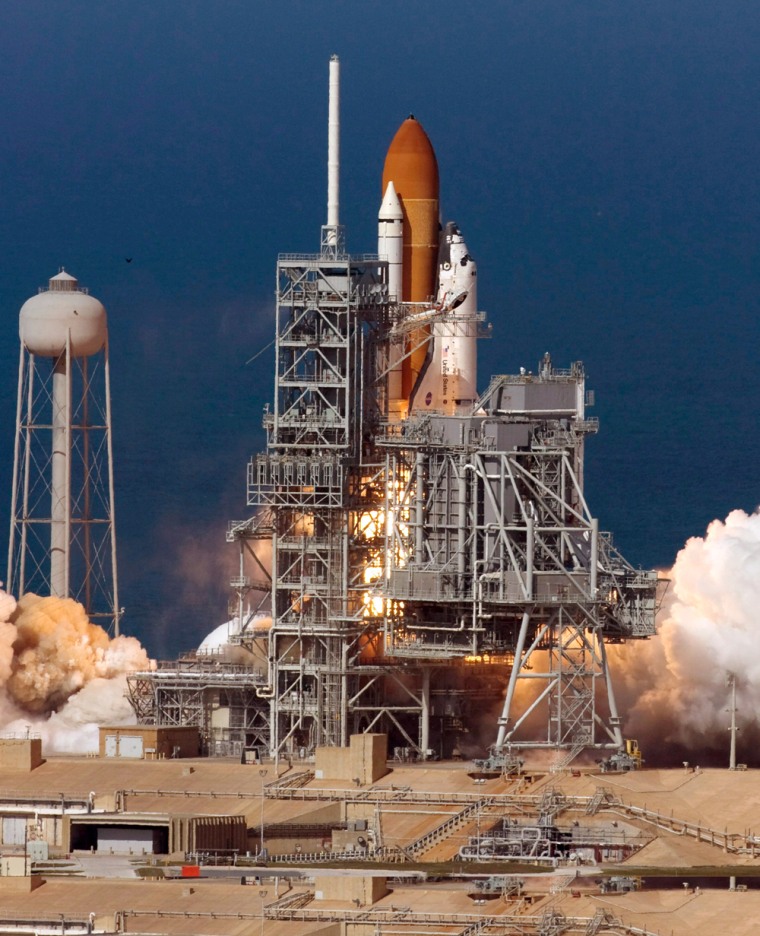The Apollo-era launch pad used to shoot space shuttle Discovery into orbit two weeks ago may have been flawed from the day it was built, and will need weeks if not months of work to fix all the liftoff damage, NASA said Thursday.
About 5,300 bricks flew off the pad during Discovery's launch on May 31, exposing a thick concrete wall underneath. The pad was built for the Apollo moon shots, and it looks as though the bricks did not adhere properly to the wall of the flame trench when they were installed in the 1960s, said LeRoy Cain, chairman of the mission management team.
While the flyaway bricks posed no danger to Discovery at liftoff — engineers have verified that's a physical impossibility — NASA wants to fix the flame trench so it does not get worse. Cain said he's confident it will be repaired in time for the next shuttle flight in October.
In orbit, Discovery's seven astronauts enjoyed a relaxed day off after their demanding construction work at the international space station. They left the orbiting complex bigger and more robust, with a new billion-dollar Japanese lab and a fully functional toilet, among other things.
Late Thursday afternoon, engineers finished scrutinizing all the wing and nose images collected by the shuttle crew Wednesday with a 100-foot laser-tipped inspection boom.
"Looks like you have a clean orbiter," Mission Control radioed. Touchdown is set for Saturday.
The thermal survey — an exhaustive search for damage — was conducted later than usual because the astronauts had to wait until they got to the space station to retrieve their inspection pole. There wasn't enough room aboard Discovery for the pole at liftoff because of the giant Kibo lab.
As for the launch pad, NASA officials have talked with a few of the men who were on the original construction team, and are digging out as many documents as possible from the archives. Construction of the launch pad began in 1963 and ended in 1965.
It looks as though some and, quite possibly, many of the heat-resistant fire bricks did not have the proper adhesion from the start, Cain said. At the very least, he said, it seems to be a contributing factor in what NASA is describing as the worst launch pad damage in space shuttle history.
The damaged area is 20 feet by 75 feet, and is located in the trench that is designed to deflect the flames at booster rocket ignition.
"We need to go understand more," Cain said at a news conference. "I don't know if it surprises me. I don't think we know enough yet for me to say that."
This special type of heat-resistant fire brick is no longer made, and it's unclear whether the original vendor could make more, Cain said.
Cain acknowledged that this launch pad is needed for only two more years — the space shuttles are scheduled to retire in 2010 — and that the repairs will be based on "what does it make sense for us to do now."
NASA's other launch pad will be transformed into a base for the rocketships that are intended to eventually return astronauts to the moon. It, too, will be inspected and repaired if necessary.
Atlantis is scheduled to blast off Oct. 8 from the pad that was damaged on one last mission to the Hubble Space Telescope. NASA has three weeks to get the shuttle up in order to keep Endeavour on track for a November liftoff, otherwise that space station visit will slip into 2009 and keep astronaut Gregory Chamitoff at the orbiting complex considerably longer than his planned six-month stay.
Discovery dropped Chamitoff off at the space station and left Wednesday with the astronaut whom he replaced, Garrett Reisman.
